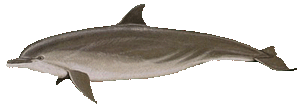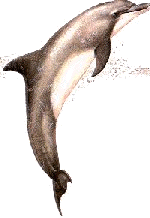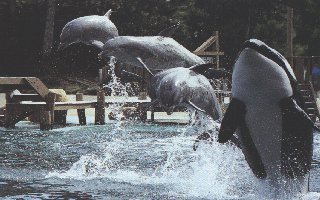
Scientific Name: Tursiops truncatus
Other Names: Bottle nosed Dolphin, Cowfish
Length: 6.3-12.8 ft. (1.9-3.9 m.)
Weight: 330-1440 lbs. (150-650 kg.)
Teeth: 74-100
Bottle nose dolphin

Scientific
Name: Tursiops truncatus
Other
Names: Bottle nosed Dolphin, Cowfish
Length:
6.3-12.8 ft. (1.9-3.9 m.)
Weight:
330-1440 lbs. (150-650 kg.)
Teeth:
74-100
Bottle nose dolphins are some of the best known species of dolphin. Many performing dolphins in zoos and aquariums are bottle nose dolphins. These dolphins vary greatly in size, shape, and color from one individual to the next. However, it appears that there are two main varieties: a smaller inshore form and a larger, more robust offshore form. In general, they are gray with darker backs than undersides. Bottle nose dolphins also have an inquisitive and active behavior. They frequently lobtail, bow ride, wake ride, and body surf. These dolphins are known to associate with other species of cetacea as well as humans, sharks, and sea turtles.
Their
playful and sociable behavior is the common reason for the popularity of
this species. Everybody must know the series called 'Flipper', they used
many bottle nosed dolphins for this series. I cried when i saw one trainer
on television telling about one dolphin who had died during the making.
The dolphin was sunburned because of the little basin he was in. When the
trainer rubbed the dolphin, he noticed there was something wrong. The dolphin
than took a deep breath and went underwater, to the bottom of the basin.
The dolphin never breath again, the trainer tried to help the dolphin on
to the surface of the water, but the dolphin didn't want to. The dolphin
had committed suicide! 
This
is enough information for me that dolphins no matter what species, may
not be held in captivity, if i could i would fight for it!!! Many links
on my homepage refer to organizations which do help and make an effort
to help stop killing dolphins and stop taking dolphins for oceanaria and
dolphinaria.
These
dolphins are very well known to general public. This is as a result of
many oceanaria and dolphinaria, films and articles. Their apparent intelligence
has attained a world wide fame. Their popularity was reflected in a television
series, where the star is a bottle nosed dolphin. From earliest times,
mariners have experienced the thrill of being escorted by groups of these
creatures which jump and dive around the ship, apparently in the pure delight
of living.
Some
individuals seem genuinely fond of men and there are many stories of them
swimming into bays to join in the frolics of bathers. Dolphins, probably
individuals of this species, make regular trips with boats. Dolphins are
well known to assist sick or injured members of their herd, helping them
to the surface to breath and staying close to them for comfort and protection.
Whilst scientists are reluctant to attribute higher emotions to creatures
other than man, such behavior may be considered an extension of normal
maternal concern.
Naval
scientists have also been interested in the sound echo or sonar apparatus
used by cetaceans.
They
have also been tempted to adapt these creatures willingness to be trained
to military purposes.
By
attaching magnetic bombs to their bodies and training them to swim toward
enemy ships on "suicide missions", they hope to overcome the difficulties
of penetrating enemy sea defenses. People can be so kind to living creatures
to serve their own needs......

The
distribution of bottle nose dolphins range from cold temperate to tropical
sea's worldwide. This species is found in
all ocean and most seas. Unfortunately this species is the commonest kept
in captivity, like the common dolphin. They are in captivity in many dolphinaria
all over the world. The vast majority of these watery circuses have no
other function than to titillate tired crowds of humans and in so doing
make a profit. The welfare of the animals is of interest only in so far
as it affects the economics of the operation. At all times of the year,
the bottle nosed dolphin has been seen in British seas, but there is a
great increase in its numbers during the summer. An annual migration approaches
from the south-west in early summer and the dolphins spread up the English
Channel, the Bristol Channel and St.George's Channel, and up the west coast
of Ireland. Some of them pass the North sea, as few get beyond the coasts
of Suffolk and Holland, on the west it is
rare off the Atlantic coast of Scotland.